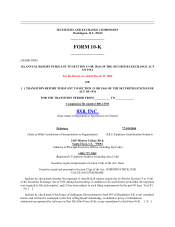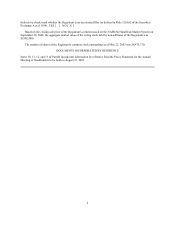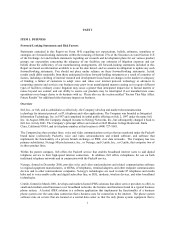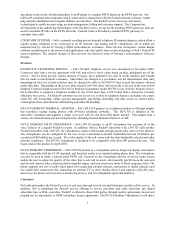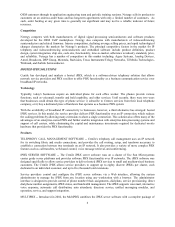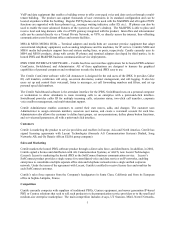8x8 2003 Annual Report Download - page 11
Download and view the complete annual report
Please find page 11 of the 2003 8x8 annual report below. You can navigate through the pages in the report by either clicking on the pages listed below, or by using the keyword search tool below to find specific information within the annual report.8
and several other providers of traditional and newer generation IP-based solutions, such as Broadsoft, Inc., Cisco
Systems, Shoreline Communications, Syndeo Corporation, Sylantro, VocalData, Inc., Vocaltec Communications,
and Vertical Networks.
MANUFACTURING
8x8 outsources the manufacturing of its videophones and DTA 310 terminal adapters, and Centile outsources the
manufacturing of its media hubs, to third-party manufacturers, which are generally also semiconductor customers of
Netergy. Neither Centile nor 8x8 have long-term purchase agreements with their contract manufacturers.
Netergy outsources the manufacturing of its semiconductors to independent foundries, and its primary
semiconductor supplier is STMicroelectronics NV, or STM, which primarily uses Taiwan Semiconductor
Manufacturing, or TSMC, for the production of Netergy’s product. Our reliance on STM and its vendors for
overseas wafer fabrication, sort, assembly and test services entails certain political and economic risks, including
political instability and expropriation, currency controls and exchange fluctuations, and changes in tariff and freight
rates. Furthermore, in the event overseas wafer fabrication, sort, assembly or test operations, or air transportation to
or from foreign foundries or contractors, were disrupted for any reason, our operations could be severely harmed.
Netergy does not have long-term purchase agreements with its contract manufacturers or its component suppliers.
RESEARCH AND DEVELOPMENT
Research and development expenses in each of the fiscal years ended March 31, 2003, 2002 and 2001 were $7.8
million, $12.6 million and $20 million, respectively. The development of new products and the enhancement of
existing products by the Company and its subsidiaries are essential to their success.
The Company's current and future research and development efforts relate primarily to its Packet8 service offering
and the development of new endpoints for subscribers of the service, and Netergy’s next generation video
semiconductor and embedded software. Areas of emphasis will include: enhanced versions of 8x8’s Packet8
telecommunication services offering and related endpoints, and enhanced versions of Netergy’s video
communication processor technology to provide support for the H.264 video compression algorithm. Future
development may also focus on emerging audio and video telephony standards and protocols, quality and
performance enhancements to multimedia compression algorithms, and additional features supporting all of the
Company's products.
INTELLECTUAL PROPERTY AND PROPRIETARY RIGHTS
Our ability to compete depends, in part, on our ability to obtain and enforce intellectual property protection for our
technology in the United States and internationally. We currently rely primarily on a combination of trade secrets,
patents, copyrights, trademarks and licenses to protect our intellectually property. As of March 31, 2003, we had
fifty-four United States patents and a number of United States and foreign patents pending, none of which we
consider critical to our business. Our patents expire on dates ranging from 2009 to 2018. We cannot predict whether
our pending patent applications will result in issued patents. Due to rapid technological change, we believe that
factors such as the technological and creative skills of our personnel, new product developments and enhancements
to existing products are more important than the various legal protections of our technology to establishing and
maintaining technology leadership.
To protect our trade secrets and other proprietary information, we require our employees to sign agreements
providing for the maintenance of confidentiality and also the assignment of rights to inventions made by them while
in our employ. There can be no assurance that our means of protecting our proprietary rights in the United States or
abroad will be adequate or that competition will not independently develop technologies that are similar or superior
to our technology, duplicate our technology or design around any of our patents. We are also subject to the risks of
adverse claims and litigation alleging infringement of the intellectual property rights of others. The semiconductor
and software industries are subject to frequent litigation regarding patent and other intellectual property rights. In
addition, the laws of foreign countries in which our products are or may be sold do not protect our intellectual
property rights to the same extent as do the laws of the United States. Our failure to protect our proprietary
information could cause our business and operating results to suffer.
We rely upon certain technology, including hardware and software, licensed from third parties. There can be no

